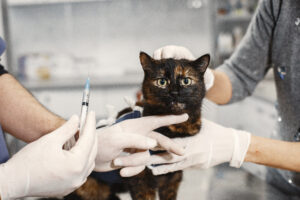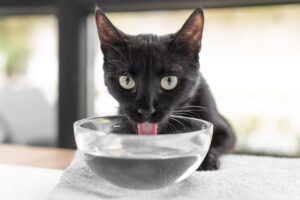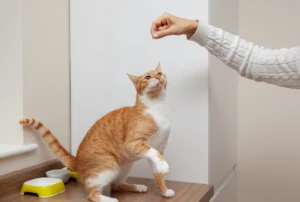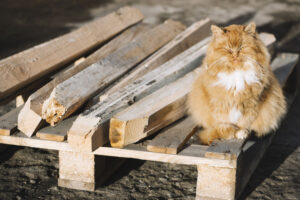Introduction
When most people think of cats, familiar breeds like Siamese, Persian, or Maine Coon might come to mind. However, the world of felines is incredibly diverse, with some unusual cat breeds that seem to have stepped straight out of a fantasy novel. These rare cat breeds often feature distinctive physical characteristics that set them apart from the average housecat, from curled ears to missing fur, twisted tails, or extraordinarily large eyes.
As a cat enthusiast, discovering unusual cat breeds can be an exciting journey. These exotic cat breeds are not just visually striking; many also have fascinating personalities and histories that make them even more intriguing. Whether you’re considering adopting a rare feline companion or simply curious about the diversity of cats worldwide, this comprehensive guide will introduce you to five of the most unusual cat breeds you’ve likely never encountered before.
In this article, we’ll explore some of the rarest cat breeds on the planet, delving into their unique features, temperaments, care requirements, and the fascinating stories behind these strange cat breeds. From hairless wonders to cats with extraordinary body structures, these unusual cat breeds will certainly captivate your imagination and perhaps change your perception of what a cat can look like.
What Makes a Cat Breed “Unusual”?
Before diving into our list of the most unusual cat breeds, it’s worth discussing what exactly qualifies a feline as “unusual.” Generally speaking, unusual cat breeds typically possess distinctive physical traits that differentiate them from conventional domestic cats. These traits might include:
- Distinctive coat patterns or textures
- Unusual body structures or proportions
- Unique facial features
- Rare genetic mutations
- Limited population numbers worldwide
These rare cat breeds often emerge through either natural genetic mutations that are subsequently bred for, or through careful selective breeding programs designed to accentuate certain traits. Many exotic cat breeds have only been recognized within the last few decades, making them relatively new additions to the cat fancy world.
Some unusual cat breeds are so rare that even dedicated cat lovers might never encounter them in person. With populations sometimes numbering only in the thousands or even hundreds worldwide, these unique cats represent some of the most exclusive feline companions available. Their rarity often contributes to their high price tags, with some of the rarest cat breeds commanding thousands of dollars from specialized breeders.
Now, let’s explore five of the most unusual cat breeds that you’ve probably never seen before.
1. The Ukrainian Levkoy: A Bat-Eared Beauty

When discussing unusual cat breeds, the Ukrainian Levkoy deserves a prominent place on the list. This strange-looking cat combines two distinctive features: the hairlessness of the Sphynx with the folded ears of the Scottish Fold, creating a truly unique appearance that some compare to a bat or an alien.
Origin and History
The Ukrainian Levkoy is one of the newest unusual cat breeds in existence, having been developed in Ukraine in the early 2000s. Breeder Elena Birjukova deliberately crossed Scottish Fold cats with Donskoy (Don Sphynx) cats to create this distinctive breed. The name “Levkoy” comes from a type of flower with folded leaves, referencing the cat’s distinctive ear shape.
As one of the rarest cat breeds globally, the Ukrainian Levkoy remains primarily found in Eastern Europe, with very few examples in North America. Unlike some unusual cat breeds with ancient histories, the Levkoy represents modern breeding innovation, making it one of the most unusual domestic cat breeds developed in recent times.
Distinctive Features
What makes the Ukrainian Levkoy one of the most unusual cat breeds is its combination of:
- Completely hairless or nearly hairless body
- Distinctive folded ears that bend forward
- Angular face with prominent cheekbones
- Almond-shaped eyes
- Long, slender body structure
This combination of features creates a highly distinctive silhouette unlike virtually any other cat breed. The Ukrainian Levkoy’s appearance makes it instantly recognizable even among other unusual looking cats.
Temperament and Care
Despite their alien appearance, Ukrainian Levkoys are known for their friendly, affectionate personalities. These unique cats typically show:
- High intelligence and curiosity
- Strong bonds with human family members
- Playful, energetic behavior well into adulthood
- Tolerance for handling and interaction
As with other hairless unusual cat breeds, Ukrainian Levkoys require special care considerations:
- Regular bathing to remove skin oils
- Protection from extreme temperatures and direct sunlight
- Careful attention to ear cleaning due to the folded structure
For those seeking truly unique cats, the Ukrainian Levkoy represents one of the most unusual cat breeds with distinctive personality traits matching their extraordinary appearance.
2. The Lykoi: Werewolf Cats

Among weird cat breeds, the Lykoi stands out for its extraordinary “werewolf” appearance. Often referred to as the “Werewolf Cat,” this unusual cat breed features a patchy, partially hairless coat that gives it the appearance of a small wild animal or mythological creature.
Origin and History
The Lykoi is one of the most unusual cat breeds with a fascinating origin story. Unlike many rare exotic cat breeds that result from deliberate breeding programs, the Lykoi emerged through a natural genetic mutation in domestic shorthair cats. The first documented Lykoi cats appeared in 2010, making them one of the newest unusual cat breeds recognized.
The name “Lykoi” derives from the Greek word for “wolf,” referencing their wolf-like appearance. Veterinary testing confirmed these strange looking cats weren’t suffering from illness or disease but possessed a natural genetic variation affecting hair growth and pattern. Since their discovery, careful breeding programs have helped establish the Lykoi as one of the most unusual cat breeds gaining recognition worldwide.
Distinctive Features
What places the Lykoi among the weirdest cat breeds is its remarkable coat and facial features:
- Partial hairlessness, particularly around the face, legs, and eyes
- Coarse, wiry hair that doesn’t form a complete coat
- Lack of undercoat
- “Mask” of hairlessness around the eyes, nose, and muzzle
- Black-roan coloration (though other colors now exist)
Interestingly, Lykoi kittens are often born with a complete coat that partially falls out as they mature, creating their distinctive werewolf appearance. This makes them one of the unusual cat breeds with changing characteristics throughout their life cycle.
Temperament and Care
Despite their somewhat feral appearance, Lykois are domestic cats with friendly temperaments:
- Highly intelligent with strong hunting instincts
- Playful and energetic behavior
- Strong bonds with human companions
- Dog-like loyalty and affection
As unusual cat breeds with unique coats, Lykois require some specialized care:
- Protection from extreme temperatures due to their incomplete coat
- Regular skin checks for sunburn or irritation
- Balanced diet to support healthy skin and hair
For those seeking strange cat breeds with both unusual appearances and engaging personalities, the Lykoi represents one of the most distinctive options among uncommon cat breeds.
3. The Peterbald: Elegant Extraterrestrial

Among unusual cat breeds with striking elegance, the Peterbald stands out with its svelte body, large ears, and range of hairlessness. This exotic cat breed combines oriental elegance with unusual skin characteristics, creating one of the most distinctive rare cat breeds in the world.
Origin and History
The Peterbald originates from St. Petersburg, Russia, where it was developed in 1994 through crossing Oriental Shorthairs with Don Sphynx cats. This makes it one of the more recently developed unusual cat breeds, though it has gained popularity faster than many other rare cat breeds.
Named for its city of origin and its sometimes bald appearance, the Peterbald represents deliberate breeding to create a cat with Oriental body structure and variable hairlessness. While not as rare as some unusual cat breeds on this list, Peterbalds remain uncommon outside Eastern Europe and among dedicated exotic cat enthusiasts.
Distinctive Features
What makes the Peterbald one of the most unusual cat breeds is its combination of:
- Extreme Oriental body type with long, slender limbs
- Wedge-shaped head with very large ears
- Almond-shaped eyes set at an angle
- Five different coat types, ranging from completely hairless to brush coat
- Distinctive wrinkled skin in hairless varieties
Unlike some unusual looking cats that have a single distinctive feature, the Peterbald combines multiple unusual traits in one elegant package. Their alien-like appearance places them firmly among the strange looking cats of the world despite their graceful bearing.
Temperament and Care
Peterbalds inherit their personality traits from their Oriental ancestors, making them:
- Extremely intelligent and curious
- Highly social and affectionate
- Vocal and communicative
- Active and playful throughout their lives
As one of the unusual cat breeds with variable hairlessness, Peterbald care requirements depend on their coat type:
- Completely hairless varieties need weekly bathing and skin protection
- “Sticky” coated cats require regular cleaning to prevent oil buildup
- All varieties need protection from extreme temperatures
For those seeking unusual cat breeds combining elegance with extraterrestrial appearance, the Peterbald represents one of the most striking unusual domestic cat breeds available.
4. The Munchkin: Controversial Short-Legged Felines

Among unusual cat breeds with distinctive body structures, the Munchkin stands out for its extraordinarily short legs. These unique cats maintain normal-sized bodies and heads but have legs that can be two to three times shorter than average, creating one of the most immediately recognizable unusual looking cats.
Origin and History
The Munchkin’s short-legged trait results from a natural genetic mutation that appeared in various cat populations throughout history. However, deliberate breeding of these short-legged cats began in the 1980s in the United States, making the Munchkin one of the more recently established unusual cat breeds.
Named after the diminutive characters from “The Wizard of Oz,” Munchkin cats have generated controversy in the cat fancy world. Some organizations refuse to recognize them due to concerns about their skeletal structure, while others classify them among acceptable unusual cat breeds. Despite this controversy, Munchkins have gained popularity among those seeking unique cats with distinctive appearances.
Distinctive Features
What places Munchkins among the most unusual cat breeds is their:
- Extremely short legs due to a natural genetic mutation
- Normal-sized head, body, and tail
- Variety of coat lengths and patterns
- Characteristic “hop” when running due to their shortened limbs
- Propensity to sit upright on their haunches like rabbits
This combination of features makes Munchkins among the strange looking cats that maintain popularity despite their controversial status. Their distinctive body structure sets them apart from virtually all other cat breeds, regardless of whether they feature short or long coats.
Temperament and Care
Despite their unusual physique, Munchkins typically display:
- Playful, kitten-like behavior throughout their lives
- High intelligence and problem-solving abilities
- Social nature with strong bonds to human companions
- Surprising agility despite their short legs
As unusual cat breeds with structural differences, Munchkins require:
- Careful monitoring of weight to prevent strain on their unique skeletal structure
- Modified environments if joint issues develop later in life
- Otherwise normal cat care appropriate to their coat length
For those seeking unique cats with personalities as distinctive as their appearance, Munchkins represent one of the most unusual cat breeds combining physical distinctiveness with engaging temperaments.
5. The Khao Manee: Ancient White Gems
Rounding out our exploration of unusual cat breeds is the Khao Manee, sometimes called the “Diamond Eye Cat.” While less visually strange than some other rare cat breeds on this list, the Khao Manee earns its place among unusual cat breeds through its extraordinary rarity outside Thailand and its mesmerizing odd-colored eyes.

Origin and History
Unlike many unusual cat breeds developed in recent decades, the Khao Manee boasts an ancient lineage going back hundreds of years in its native Thailand. Originally bred exclusively for Thai royalty, these cats were considered highly auspicious and were carefully controlled, making them among the rarest cat breeds both historically and today.
The name “Khao Manee” translates to “white gem,” referencing both their pure white coats and their gem-like eyes. While ancient in Thailand, these unusual cat breeds only gained recognition in Western cat fancy organizations within the last decade, making them among the rare cat breeds you’ve likely never heard of despite their long history.
Distinctive Features
What places the Khao Manee among unusual cat breeds is their combination of:
- Pure white coat without any markings
- Striking odd-colored eyes (one blue, one gold is most prized)
- Medium muscular body with a “hard” feel rather than soft
- Heart-shaped face with distinctive structure
- Extremely rare genetic background
While not as visually bizarre as some other strange looking cats on this list, the Khao Manee’s jewel-like eyes and historical exclusivity make it one of the most unusual cat breeds in terms of rarity and mystique.
Temperament and Care
Khao Manees are known for their:
- Highly intelligent and interactive nature
- Strong bonds with human family members
- Playful behavior well into adulthood
- Vocal communication with distinctive voices
As white cats with special eye characteristics, Khao Manees require:
- Protection from excessive sunlight to prevent skin cancer
- Regular cleaning around the eyes to prevent staining
- Routine care similar to other shorthaired cats
For those seeking unusual cat breeds with historical significance and striking features, the Khao Manee represents one of the most unusual cat breeds with both ancient lineage and extraordinary rarity.
Honorable Mentions: Other Unusual Cat Breeds
While our focus has been on five of the most unusual cat breeds, the world of rare and strange cat breeds extends much further. Other notable contenders for the weirdest cat breeds include:
The Sphynx
Perhaps the most famous of the unusual cat breeds, these hairless cats feature wrinkled skin and large ears that give them a distinctive alien appearance. Despite being unusual looking cats, Sphynxes have gained mainstream popularity compared to many other rare cat breeds.
The Devon Rex
With their pixie-like faces, large ears, and wavy, downy coats, Devon Rex cats represent some of the most unusual cat breeds with fairy-tale appearances. Their distinctive coat results from a natural mutation.
The American Curl
Named for their distinctive backwards-curling ears, American Curls feature a genetic mutation that creates one of the most immediately recognizable unusual cat breeds. Their ears start normal at birth but begin curling within days.
The Scottish Fold
Another breed defined by unusual ears, Scottish Folds feature distinctive folded-down ears that give them an owl-like appearance. These unusual cat breeds have gained popularity despite controversy surrounding the genetic mutation responsible for their ear structure.
The Cornish Rex
With their curly, extremely short coats and slender bodies, Cornish Rex cats represent some of the most unusual cat breeds in terms of texture. Their coats lack guard hairs, consisting only of down.
The LaPerm
Named for their curly “permanent wave” coats, LaPerms feature unusual cat breeds with curly whiskers to match their curly fur. They developed from a spontaneous mutation in working farm cats.
Are Unusual Cat Breeds Right for You?
Before seeking out rare cat breeds as pets, potential owners should consider several important factors:
Health Considerations
Many unusual cat breeds result from genetic mutations that, while creating their distinctive appearances, may also bring health challenges:
- Hairless unusual cat breeds often have dental issues and temperature regulation problems
- Cats with skeletal mutations may develop joint problems
- Breeds with folded ears can experience cartilage issues
- Rare cat breeds may have limited genetic diversity
Responsible ownership of unusual cat breeds requires research into these potential health issues and budgeting for specialized veterinary care.
Ethical Considerations
Some unusual cat breeds, particularly those with extreme physical characteristics, raise ethical questions about breeding practices:
- Breeds with debilitating mutations may experience reduced quality of life
- Some of the rarest cat breeds have very limited genetic pools
- Demand for weird cat breeds can encourage irresponsible breeding
Potential owners should research the ethics surrounding specific unusual cat breeds before seeking them out.
Care Requirements
Many unusual cat breeds require specialized care beyond what’s needed for conventional cats:
- Hairless breeds need regular bathing and skin protection
- Breeds with unusual coat textures may need special grooming tools
- Some rare cat breeds have specific dietary needs
- Unusual looking cats may need temperature-controlled environments
Before adopting any of these unique cats, ensure you can meet their specific care requirements.
Finding Reputable Breeders
Due to their rarity and often high prices, unusual cat breeds can attract unethical breeding practices. When seeking rare cat breeds:
- Research breeders thoroughly
- Ask for health testing documentation
- Meet parent cats when possible
- Be wary of prices significantly below breed averages
- Consider rescues specializing in unusual cat breeds
Conclusion
The world of unusual cat breeds offers a fascinating glimpse into the incredible diversity of our feline companions. From the werewolf-like Lykoi to the elegant Peterbald, strange-eared Ukrainian Levkoy to the ancient Khao Manee, and the controversial Munchkin, these rare cat breeds demonstrate the remarkable range of features possible within the domestic cat species.
Whether you’re considering adding one of these unique cats to your family or simply appreciating the diversity of unusual cat breeds from afar, these strange looking cats remind us of the wonderful variety present in the feline world. While many of these unusual cat breeds remain rare, their distinctive appearances and engaging personalities continue to captivate cat enthusiasts worldwide.
For those seeking companions among the most unusual cat breeds, remember that these rare exotic cat breeds require the same love, care, and attention as their more common counterparts—with perhaps a few extra considerations for their unique features. With proper research and preparation, living with unusual cat breeds can be an incredibly rewarding experience for the right owners.
From hairless wonders to curly-coated curiosities, long-legged beauties to short-legged charmers, the world of unusual cat breeds continues to evolve and surprise us with new variations and distinctive features. As more cat lovers discover these rare cat breeds, perhaps some of today’s weirdest cat breeds will become tomorrow’s beloved companions worldwide.
FAQs About Unusual Cat Breeds
Are unusual cat breeds more expensive than common cats?
Yes, most rare cat breeds command significantly higher prices than common domestic cats. The rarest cat breeds can cost anywhere from $1,000 to over $10,000 depending on their lineage and characteristics.
Do unusual cat breeds have more health problems?
Many unusual cat breeds do have specific health concerns related to the genetic mutations that create their distinctive appearances. Responsible breeders work to minimize these issues, but potential owners should research breed-specific health problems.
Are unusual looking cats good with children?
This varies by breed. Some unusual cat breeds are quite social and enjoy children, while others prefer quieter environments. Research the specific temperament of any rare cat breeds you’re considering.
Can I find unusual cat breeds in shelters?
While rare, some unusual cat breeds occasionally appear in specialized rescue organizations or breed-specific rescues. Adoption is less common for the rarest cat breeds but can happen, particularly for adult cats.
Do veterinarians charge more to treat unusual cat breeds?
Some unusual cat breeds may require specialized veterinary knowledge or treatments, which can increase costs. Before adopting rare exotic cat breeds, discuss potential care requirements with your veterinarian.
This article about unusual cat breeds was written to provide information about some of the world’s rarest and most distinctive feline companions. For more fascinating content about cats and other pets, visit PetsPump for our complete guide to cat care and breeds.
References and Further Reading
- International Cat Association. (2023). “Breed Standards and Recognition.” www.tica.org
- Cornell University College of Veterinary Medicine. (2022). “Feline Genetics and Breed Disorders.” www.vet.cornell.edu
- Journal of Feline Medicine and Surgery. (2023). “Health Considerations in Specialized Cat Breeds.” journals.sagepub.com
- Cat Fanciers’ Association. (2024). “Breed Profiles and Standards.” www.cfa.org
- American Veterinary Medical Association. (2023). “Genetic Diversity in Purebred Cats.” www.avma.org
For more information about caring for unusual cat breeds or to learn about other fascinating cat topics, visit our comprehensive cat care guides at PetsPump.






